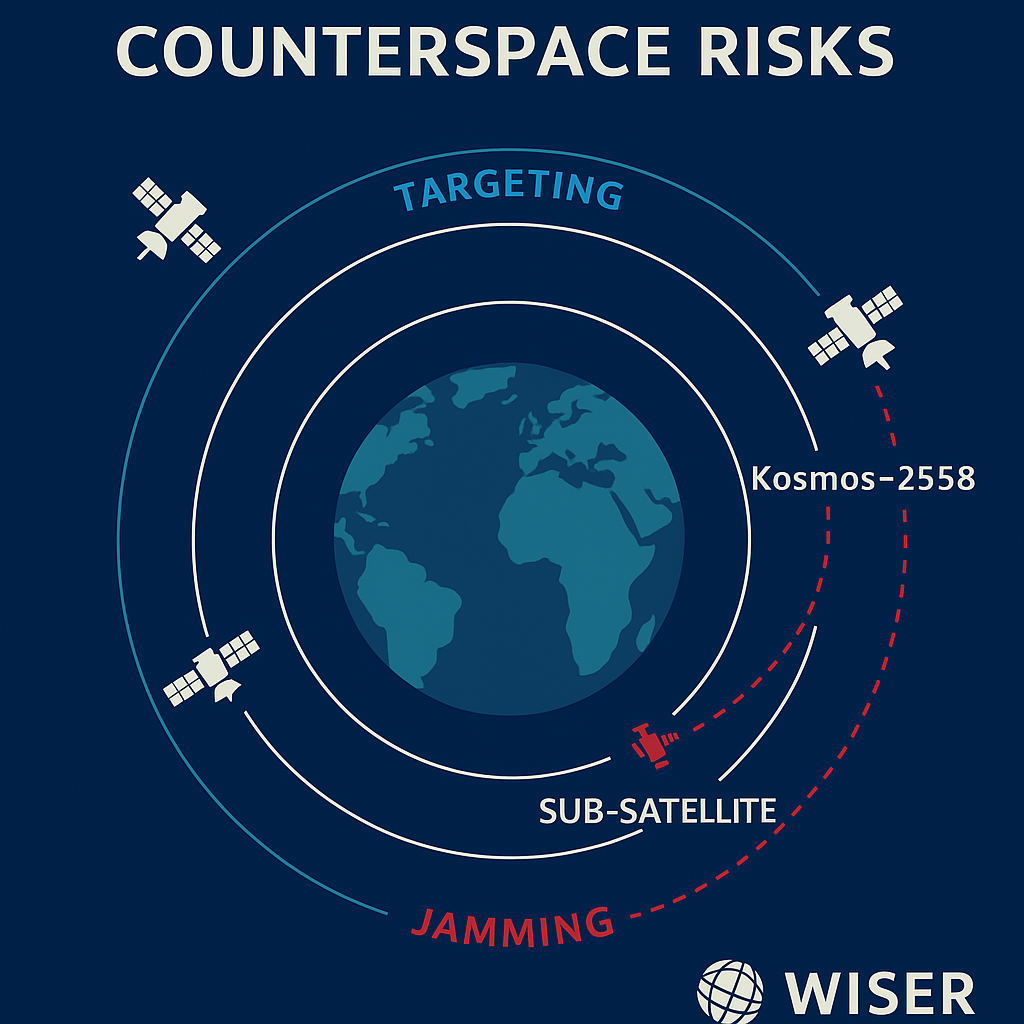Recent developments have brought the threat of space warfare into sharp focus. In mid‑2025, Russia launched a satellite, widely referred to as a “killer satellite,” that deployed a smaller object into close proximity with a U.S. intelligence satellite, behaving much like an anti‑satellite weapon. This escalation of orbital aggression underscores the increasing militarization of space.
Additionally, a separate Russian satellite launched in 2022 is suspected of facilitating the advancement of nuclear-capable anti-satellite systems. Such capacity, if weaponized, would violate the spirit of early space treaties and significantly change the strategic balance in orbit. The risk here extends beyond direct attacks. Collisions involving military satellites or debris could trigger cascading failures in orbit, potentially disabling civilian and defense infrastructure alike through what is known as the Kessler syndrome, where debris creates an ever-worsening collision environment.
Starlink and Strategic Dependence: The Private Sector’s Growing Footprint
Parallel to state-led militarization, private sector players, especially SpaceX’s Starlink constellation, are emerging as critical strategic assets. With thousands of satellites in low-Earth orbit, Starlink now delivers broadband globally and supports military connectivity, including operations in Ukraine.
However, this strategic utility comes with risks. Analysts, including those connected with Chinese defense research, have sounded alarms about Starlink’s vulnerabilities, suggesting that future adversaries could target the constellation through cyber attacks, laser strikes, or even launch counter-satellites. Meanwhile, SpaceX’s Starlink service has faced scrutiny for operational decisions that affected military capabilities. In 2022, a public choice by SpaceX to deny Starlink connectivity for a Ukrainian mission illustrated the fragility of relying on a single private company for critical infrastructure. These incidents have prompted calls for clearer governance frameworks around the role of private entities in global security.
The Convergence of State and Private Interests: Navigating Strategic Tensions
The rise of commercial space firms like SpaceX complicates traditional security models. While companies innovate rapidly and reduce launch costs, their strategic alignment with national interests is not guaranteed. NASA’s ambitious Moon-to-Mars Artemis program, for instance, has come to depend heavily on private providers, raising concerns about delays, contractual conflicts, and the broader impacts of private influence on space policy and mission timelines.
At the same time, rival states view both governmental and commercial space capabilities as extensions of American power. U.S. space doctrine now envisions space as a contested frontier. Chinese and Russian investments in their own satellite constellations and antisatellite capabilities reflect a mounting wariness and a desire to counterbalance U.S. dominance. As nations escalate their presence in orbit, the possibility of miscalculation or accidental collision increases rapidly.
Without robust international norms or effective enforcement mechanisms, the steady militarization of space, and the proliferation of corporate satellites, may lead to unintended conflict. Incidents involving “inspector” satellites that shadow national assets highlight how minor encounters can rapidly escalate without shared protocols or transparency.
Toward an Architecture of Responsible Space Governance
The evolving space security landscape demands comprehensive reform. First, foundational space law must be updated. Existing treaties, primarely from the 1960s, do not adequately address anti-satellite weapons, private mega-constellations, or liability for damage caused in orbit. Policymakers, space agencies, and international legal bodies must collaborate to craft new or revised norms that address these gaps.
Second, redundancy must be built into strategic infrastructure. States should avoid reliance on a single private company for critical capabilities. Alliances and private-public consortia should diversify procurement, access, and operational control.
Third, space traffic coordination and debris mitigation must become global priorities. National regulations and international best practices should mandate responsible satellite decommissioning, collision avoidance protocols, and active debris removal efforts.
Confidence-building measures, such as shared space situational awareness data, common norms for proximity operations, and emergency communication channels, can reduce the risk of misinterpretation and conflict.
Securing the Final Frontier Through Balanced Governance
The current era reveals a space environment where state rivalry and corporate innovation collide. As Russia tests “killer satellites” and private networks like Starlink become strategic lifelines, the risk of orbital conflict, or unintentional systemic collapse, grows.
To safeguard the utility of space for communication, science, and security, balanced partnerships are essential. Governments and private actors must coordinate to establish inclusive governance systems, enforce transparency and resilience standards, and ensure equitable access to space benefits. Otherwise, the final frontier risks becoming a contested battleground where profit eclipses safety, and state strategy overrides global stability.
The decisions made today regarding space policy, commercial oversight, and international cooperation will determine whether space remains a domain of shared utility or becomes another arena of global rivalry.
References
AP News. “SpaceX’s Starlink Faces Strategic Concerns Amid Rising Global Tensions.” 2025.
The Sun. “Russian ‘Killer Satellite’ Sparks Latest Fears in U.S. Military.” June 2025.
Politico. “U.S. Space Chief Warns of Emerging Threats from China and Russia.” May 2025.
Reuters. “Orbital dogfights’: Taiwan’s worries drive new space warfare era.” June 2025.
United Nations Open‑Ended Working Group on Reducing Space Threats reports.
NASA Artemis Accords documentation.

